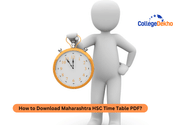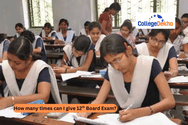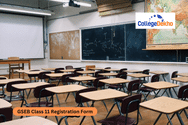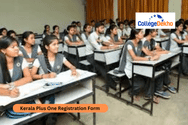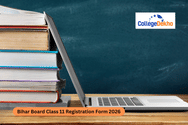West Bengal HS Syllabus 2025-26 consists of chapters and topics included in each subject. WBCHSE has divided class 11th and 12th exams into four semesters, which will continue for the 2026 academic year also.
- West Bengal HS Syllabus 2025-26 PDF Download
- West Bengal HS English Syllabus 2025-26
- West Bengal HS Physics Syllabus 2025-26
- West Bengal HS Mathematics Syllabus 2025-26
- WB HS Chemistry Syllabus 2025-26
- WB HS Biological Sciences Syllabus 2025-26
- West Bengal HS Business Studies Syllabus 2025-26
- West Bengal HS Political Science Syllabus 2025-26
- West Bengal HS History Syllabus 2025-26
- West Bengal HS Sociology Syllabus 2025-26
- Faqs


Never Miss an Exam Update
West Bengal HS Syllabus 2025-26 consists of the curriculum for all subjects. According to the changes made by the West Bengal Council for Higher Secondary Education, classes 11th and 12th exams are now merged into 4 semesters, which will continue for 2026 also. Each semester will carry 40 marks. The theory paper will be conducted for 40/35 marks according to the nature of the subject, and the remaining marks will be allotted for the internal assessment. You can find the official PDF of the syllabus on the website of WBCHSE at wbchse.wb.gov.in. Do not forget to also download the WB Board Class 12 Exam Pattern 2025-26 .
If you want to check out the West Bengal HS Syllabus 2025-26, read below:
Download West Bengal HS Routine 2026
West Bengal HS Syllabus 2025-26 PDF Download
Check the direct PDFs of the syllabus from the table given below:
Subjects | Download Link |
|---|---|
Hindi | |
English | |
Physics | |
Mathematics | |
Chemistry | |
Biological Science | |
Accountancy | |
Business Studies | |
Political Science | |
Philosophy | |
Sociology | |
Economics | |
History | |
Psychology | |
Geography |
West Bengal HS English Syllabus 2025-26
Students can refer to the syllabus for English from the table given below and use it to efficiently prepare for the exam:
Semester 1
Units | Topics |
|---|---|
UNIT 1: PROSE | 1. ‘War’ by Luigi Pirandello |
2. ‘Debut on Stage’ by Charles Chaplin | |
3. ‘The Legends of Pensam’ by Mamang Dai | |
UNIT 2: VERSE | 1. ‘Ode to the West Wind’ by P. B. Shelley |
2. ‘My Grandmother’s House’ by Kamala Das | |
UNIT 3: DRAMA | ‘The Glass Menagerie’ by Tennessee Williams (Scene I to IV) |
UNIT 4: TEXTUAL GRAMMAR | Textual Grammar from Unit 1 and Unit 2: Synthesis and Splitting of Sentences; Change of Narration; Correction of errors |
UNIT 5: READING COMPREHENSION | Reading Comprehension (Unseen) |
Total | - |
Semester 2
Units | Topics |
|---|---|
UNIT 1: PROSE | 1. ‘Mr. Pirzada’ by Jhumpa Lahiri |
2. ‘The Lamb of the Slaughter’ by Roald Dahl | |
UNIT 2: VERSE | 1. ‘Last Ride Together’ by Robert Browning |
2. ‘I cannot live with thee’ by Emily Dickinson | |
3. ‘This is a Photograph of Me’ by Margaret Atwood | |
UNIT 3: DRAMA | ‘The Glass Menagerie’ by Tennessee Williams (Scene V to VII) |
UNIT 4: NONTEXTUAL GRAMMAR | Non-textual Grammar: Synthesis and Splitting of Sentences; Change of Narration; Correction of Errors |
UNIT 5: WRITING SKILL | Essay |
Total | - |
West Bengal HS Physics Syllabus 2025-26
You can refer to the detailed syllabus for Physics from the table given below:
Semester 1
UNIT No. | Topics | Subtopics |
|---|---|---|
1 | Electrostatics | SUB TOPICS: ELECTRIC CHARGES AND FIELDS Electric charges, conservation of charge. Coulomb's law - force between two point charges, forces between multiple charges, superposition principle and continuous uniform distribution of charges. Electric field: electric field due to a point charge, electric field lines. Electric dipole, electric field due to a dipole (at a point on its axis, at a point on its perpendicular bisector, at any point), torque on a dipole in uniform electric field. Electric flux, statement of Gauss's theorem and its application to find the field due to infinitely long straight wire, uniformly charged infinite plane sheet and uniformly charged thin spherical shell (field inside and outside) SUB TOPICS: ELECTROSTATIC POTENTIAL AND CAPACITANCE Electric potential, potential difference, relation between electric field intensity and potential, electric potential : due to a point charge, a dipole and system of point charges, equipotential surface and its properties, electrical potential - energy of a system of two point charges and of electric dipole in electrostatic field. Conductors and insulators, free charges and bound charges inside a conductor. Dielectrics and electric polarization. Capacitors and capacitance, combination of capacitors in series and in parallel. Capacitance of parallel plate capacitors with or without dielectric medium between the plates. Capacitances of solid and hollow spherical capacitors. Energy stored in a capacitor. Example of capacitors in our daily life (only qualitative idea ) |
2 | Current electricity | Electric current, flow of electric charge in a metallic conductor. Drift velocity, mobility and their relation with electric current. Ohm's law, electrical resistance, resistivity and conductivity. V-I characteristics for ohmic resistance, temperature dependence of resistance. Series, parallel and mixed grouping of resistances. Internal resistance of a cell, potential difference and emf of a cell, combination of cells in series and in parallel and in mixed grouping. Parallel combination of two cells of unequal emfs, series combination of n cells of unequal emfs. Kirchhoff's law and simple applications. Wheatstone bridge principle, Metre Bridge principle (end error correction not required). Potentiometer: principle and its applications to measure the potential difference and for comparing emfs of two cells and measurement of internal resistance of a cell. |
3 | Magnetic effects of current and magnetism | SUB TOPICS: MOVING CHARGE AND MAGNETIC FIELD Concept of magnetic field, Oersted's experiment. Biot - Savart law, calculation of magnetic field for linear and circular current carrying conductors and its simple applications. Ampere's circuital law and its application to infinitely long straight wire and straight solenoid. Force on a moving charge in a uniform magnetic and electric fields - Lorentz force. Motion of a charged particle in a perpendicular magnetic field (Cyclotron frequency). Force on a current carrying conductor in a uniform magnetic field. Force between two parallel current carrying conductors - definition of ampere. Torque experienced by a current carrying loop in uniform magnetic field, moving coil galvanometer -its current sensitivity. Conversion of galvanometer into ammeter and voltmeter. SUB TOPICS: MAGNETISM AND MATTER Current loop as a magnetic dipole and its magnetic dipole moment. Magnetic dipole moment of a revolving electron. Magnetic field intensity due to a magnetic dipole (bar magnet) along its axis and perpendicular to its axis. Torque on a magnetic dipole (bar magnet) in a uniform magnetic field, magnetic field lines. Magnetic properties of a material: magnetic permeability, magnetic susceptibility, intensity of magnetization, magnetic retentivity and coercivity. Hysteresis: B - H loop and its significance, (only qualitative idea) Earth's magnetic field and magnetic elements. Dia, Para and Ferro - magnetic substances with examples. Electromagnets and factor affecting their strengths. |
4 | Electromagnetic induction and alternating current | SUB TOPICS : ELCTROMAGNETIC INDUCTION Electromagnetic induction, concept of magnetic flux. Faraday's laws, induced emf and current, Lenz's law, Eddy current. Concept of self and mutual inductance, self-inductance of a solenoid and mutual inductance of two coaxial solenoids (qualitative ideas). SUB TOPICS : ALTERNATING CURRENT Alternating current, peak and RMS values of alternating current/voltage, reactance and impedance. Concept of phasor diagram, only resistive circuit, only inductive circuit , only capacitive circuit, LR circuit, CR circuit, and LCR series circuit, resonance, LC oscillator (qualitative idea only). Power in AC circuit, power factor in AC circuit, wattless current. AC generator and transformer |
5 | Electromagnetic waves | Basic idea of displacement current, electromagnetic waves and their characteristics (qualitative ideas only). Transverse nature of electromagnetic waves. Electromagnetic spectrum (radio waves, infrared, visible, ultraviolet, X-rays, Gamma Rays) including elementary facts about their uses. |
Semester 2
UNIT No. | Topics | Sub-Topics |
|---|---|---|
6 | Optics | SUB TOPICS : RAY OPTICS AND OPTCAL INSTRUMENTS Reflection of light, spherical mirrors, mirror formula, refraction of light, total internal reflection and its applications, optical fibers. Refraction at spherical surfaces, lenses, thin lens formula. Lens -Maker's Formula. Displacement method to find the position of image (conjugate points), magnification power of a lens. Combination of thin lenses in contact, combination of lens and mirrors. Refraction and dispersion of light through a Prism. Scattering of light - blue colour of the sky and reddish appearance of the sun at sunrise and sunset. Optical instruments: human eye, image formation and accommodation, correction of eye defects (myopia and hypermetropia) only qualitative Ideas. Microscopes and astronomical telescopes (reflecting and refracting) and their magnifying powers. SUB TOPICS : WAVE OPTICS Wave front and Huygens' principle, reflection and refraction of plane wave at a plane surface using Huygens' principle. Interference: interference of monochromatic light by double slits –Young’s experiment, conditions for sustained interference of light - coherent sources, condition of maxima and minima in the term of path difference and phase difference, expression for the fringe width. Diffraction: Fraunhoffer's diffraction due to single slit, width of central maximum. Resolving power of microscope and astronomical telescope. Polarization, plane polarized light. Brewster's law, uses of plane polarized light and polaroid. |
7 | Dual nature of radiation and matter | Dual nature of radiation. Photoelectric effect. Hertz and Lenard's observations, Einstein's Photoelectric equation - particle nature of light. Matter waves - wave nature of particles, de Broglie relation and its simple applications. |
8 | Atoms and nuclei | SUB TOPICS: ATOMS Alpha - particle scattering experiment, Rutherford's model of atom, Bohr model of hydrogen like atoms, energy levels, hydrogen spectrum. Elementary theory of X -ray production, continuous and characteristic X-ray(their origin and properties only),Moseley's law. SUB TOPICS : NUCLEI Composition and size of nucleus, atomic mass, isotope, isobar, isotone. Radioactivity: alpha, beta and gamma particles / rays and their properties, radioactive decay law. Mass - energy relation, mass defect, binding energy per nucleon and its variation with mass number, Nuclear fission and fusion |
9 | Electronic devices | Thermal emission of electrons and only the basic concepts of vacuum diode and triodes. Energy bands in solids: conductors, insulators and semiconductors ( qualitative idea only) Intrinsic and extrinsic semiconductors, band diagram. P- N junction diode, forward and reverse bias, I - V characteristics of junction diode (nonlinear concept). Special type of diodes: LED, photodiode, solar cell and Zener diode with their characteristics. Zener diode as a voltage regulator. Junction transistor, npn and pnp transistor, transistor action, characteristics of a transistor, transistor as an amplifier (common emitter configuration). Transistor as a switch. Elementary idea of analogue and digital signals. Concepts of decimal and binary numbers. Logic gates : OR,AND,NOT,NAND,NOR (Symbols, input, output Boolean equations, truth table, qualitative explanation). Simple cases of combination of gates. |
10 | Communication system | Elements of a communication system (Block diagram only), concepts of amplitude and frequency modulation. Band width of signals (speech, TV and digital data). Band width of transmission medium. Propagation of electromagnetic waves in the atmosphere, sky wave and space wave propagation (qualitative idea only). |
West Bengal HS Mathematics Syllabus 2025-26
You can refer to the syllabus for Mathematics from the table given below:
Units | Topics |
|---|---|
Relations and Functions | 1. Relations and Functions Types of relations: Reflexive, symmetric, transitive and equivalence relations. One-to-one and onto functions, composite functions, inverse of a function. 2. Inverse Trigonometric Functions Definition, range, domain, principal value branches. Graphs of inverse trigonometric functions. Elementary properties of inverse trigonometric functions |
Algebra | 1. Matrices Concept, notation, order, equality, types of matrices, zero matrix, identity matrix, transpose of a matrix, symmetric and skew-symmetric matrices. Addition, multiplication and scalar multiplication of matrices; properties of addition, multiplication and scalar multiplication. Simple properties of addition, multiplication and scalar multiplication. Non-commutativity of multiplication of matrices. Existence of non-zero matrices whose product is a zero matrix (restrict to square matrices of order 2). Invertible matrices and proof of the uniqueness of inverse (if it exists). (Here all matrices will have real entries). 2. Determinants Determinant of a square matrix (upto 3 × 3 matrices), properties of determinants, minors, cofactors and application of determinants in finding the area of a triangle. Adjoint and inverse of a square matrix. Consistency, inconsistency and number of solutions of system of linear equations by examples. Solutions of system of linear equations in two or three variables (having unique solution) using inverse of a matrix. |
Calculus | 1. Continuity and Differentiability Concept of Continuity and differentiability, derivative of composite functions, chain rule, derivatives of inverse trigonometric functions, derivative of implicit functions, concept of exponential and logarithmic functions, Derivatives of logarithmic and exponential functions, Logarithmic differentiation, derivative of functions expressed in parametric forms. Second order derivatives. 2. Application of Derivatives Application of derivatives, Rate of change of quantities, increasing and decreasing functions, tangents and normals, maxima and minima (first derivative test motivated geometrically and second derivative test given as a provable tool). Simple problems on basic principles and real life situations. |
Probablity | Conditional Probability, Multiplication theorem on probability, independent events, total probability, Bayes’ theorem, Random variable and its probability distribution. Mean and variance of a random variable. |
Vectors and Three-Dimensional Geometry | 1. Vectors Vectors and scalars, magnitude and direction of a vector. Direction cosines and direction ratios of a vector. Types of vectors (equal, unit, zero, parallel and collinear vectors), position vector of a point, negative of a vector, components of a vector, addition of vectors, multiplication of a vector by a scalar, position vector of a point dividing a line segment in a given ratio. Definition, Geometrical Interpretation, properties and application of scalar (dot) product of vectors, vector (cross) product of vectors. 2. Three-Dimensional Geometry Introduction to 3D geometry, Coordinate axes and coordinate planes in 3D. Coordinates of a point, distance between two points, Direction cosines and direction ratios of a line joining points. Cartesian equation and vector equation of a line, skew lines, shortest distance between two lines. Angle between two lines. |
Calculus | 1. Integrals Integration as inverse process of differentiation. Integration of a variety of functions by substitution, by partial fractions and by parts. Evaluation of simple integrals of the following types and problems based on them. Fundamental theorem of Calculus (without proof). Basic properties of definite integrals and evaluation of definite integrals 2. Applications of the Integrals Applications in finding the area under simple curves, especially lines, circles/ parabolas/ ellipses (in standard form only) 3. Differential Equations Definition, order and degree, general and particular solutions of a differential equation. Solution of differential equations by method of separation of variables, solutions of homogeneous differential equations of first order and first degree. Solutions of linear differential equation of the type: |
Linear Programming | Introduction, related terminology such as constraints, objective function, optimization, graphical method of solution for problems in two variables, feasible and infeasible regions (bounded or unbounded), feasible and infeasible solutions, optimal feasible solutions (up to three non-trivial constraints). |
WB HS Chemistry Syllabus 2025-26
You can check the semester-wise syllabus for Chemistry from the table given below:
Semester III
Unit No. | Topics |
|---|---|
Unit 1 | Liquid State – Solubility, Vapour Pressure, Raoult’s Law, Colligative Properties, Van’t Hoff Factor, Colloids and Their Properties |
Unit 2 | p-Block Elements (Groups 15–18): Group 15 – Nitrogen & Phosphorus Compounds Group 16 – Oxygen & Sulphur Compounds Group 17 – Halogens, Interhalogen Compounds Group 18 – Noble Gases, Xenon Compounds |
Unit 3 | Haloalkanes and Haloarenes – Nomenclature, Properties, Substitution Reactions, Carbocation Stability, Environmental Effects |
Unit 4 | Alcohols, Phenols and Ethers – Nomenclature, Preparation, Properties, Dehydration, Electrophilic Substitution, Uses |
Unit 5 | Biomolecules – Carbohydrates, Proteins, Enzymes, Nucleic Acids (DNA & RNA) |
Unit 6 | Polymers – Classification, Polymerization Methods, Synthetic and Natural Polymers, Biodegradable Polymers |
Semester IV
Unit No. | Topics |
|---|---|
Unit 1 | Electrochemistry – Conductivity, Electrolysis, EMF, Nernst Equation, Batteries, Fuel Cells |
Unit 2 | Chemical Kinetics – Reaction Rates, Rate Law, Half-Life, Activation Energy, Catalysis |
Unit 3 | d- and f-Block Elements – Transition Metals, K₂Cr₂O₇, KMnO₄, Lanthanoids, Actinoids |
Unit 4 | Coordination Compounds – Ligands, Bonding Theories, Nomenclature, Isomerism, Applications |
Unit 5 | Aldehydes, Ketones and Carboxylic Acids – Preparation, Properties, Reactions, Uses |
Unit 6 | Organic Compounds Containing Nitrogen – Nitro Compounds, Amines, Cyanides, Isocyanides, Diazonium Salts |
WB HS Biological Sciences Syllabus 2025-26
You can check the units and topics for Biology here. This will help you to prepare and score high marks.
UNIT No. | TOPICS |
|---|---|
UNIT VI | REPRODUCTION |
Chapter 1: Sexual Reproduction in Flowering Plants - Flower structure - Development of male and female Gametophytes - Pollination — Types, Agencies and examples - Out breeding devices - Pollen pistil interaction - Double fertilization - Post-fertilization events: development of endosperm and embryo, development of seed and formation of fruit - Special modes — Apomixis, Parthenocarpy, Polyembryony - Seed dispersal and fruit formation and their significance | |
Chapter 2: Human Reproduction - Male and female reproductive systems - Anatomy and Histology of testis and ovary - Gametogenesis: Spermatogenesis and Oogenesis - Menstrual cycle - Fertilization, embryo development up to blastocyst, formation and implantation - Pregnancy and placenta formation and function - Parturition: mechanism and neuroendocrine system involved in this mechanism - Lactation | |
Chapter 3: Reproductive Health - Need for reproductive health and prevention of sexually transmitted diseases (STDs) - Birth control: need and methods - Contraception and medical termination of pregnancy (MTP) - Amniocentesis - Infertility and Assisted reproductive technologies: IVF, ZIFT, GIFT (elementary idea for general awareness) | |
UNIT VII | GENETICS AND EVOLUTION |
Chapter 4: Principles of Inheritance and Variation - Heredity and Variation: Mendelian inheritance - Deviations from Mendelism: Incomplete dominance, Co-dominance, Multiple alleles and inheritance of blood groups, Pleiotropy - Elementary idea of polygenic inheritance - Chromosome theory of inheritance - Chromosomes and genes, sex determination in humans, birds and honeybees - Linkage and crossing over - Sex linked inheritance: hemophilia, color blindness - Mendelian disorders in humans: Thalassemia - Pedigree Analysis - Chromosomal disorders in humans: Down’s syndrome, Turner’s syndrome and Klinefelter’s syndrome | |
Chapter 5: Molecular Basis of Inheritance - Search for genetic material and DNA as genetic material (experiments on bacterial transformation by F. Griffith; Avery, MacLeod and McCarty; Experiment by Hershey and Chase) - Structure of DNA and RNA - DNA packaging - DNA replication - Central Dogma - Genetic Code, Translation, gene expression and regulation: lac operon - Genome, Human and Rice genome projects - DNA fingerprinting | |
Chapter 6: Evolution - Origin of life - Biological evolution and evidences for biological evolution (Palaeontology, Embryology and molecular evidence) - Darwin's contribution, modern synthetic theory - Mechanism of evolution: Variation (Mutation and Recombination) and Natural selection with examples, types of natural selection - Gene flow and genetic drift - Hardy-Weinberg Principle - Adaptive radiation - Human evolution | |
UNIT VIII | BIOLOGY AND HUMAN WELFARE |
Chapter 7: Human Health and Diseases - Basic concept of immunology: Immune system, Antigen, Antibody, antigen-antibody reaction, Types of immunity - vaccine and vaccinations - Pathogens: Parasites causing human diseases: Malaria, Filariasis, Chikungunya, Dengue, Ascariasis, Typhoid, Pneumonia, Common Cold, Amoebiasis, Ringworm, SARS (COVID), Allergy and Autoimmune disorders - Symptoms of disease, Name of causative agents, Mode of transmission, Preventive measures - Cancer, HIV and AIDS: Symptoms of diseases, Causative agents, Mode of transmissions, Preventive measures - Adolescence: Drug and alcohol abuse | |
Chapter 8: Improvement in Food Production - Plant breeding, Tissue culture, Single cell Protein | |
Chapter 9: Microbes in Human Welfare - Microbes in food processing, Industrial production, Sewage treatment, Energy generation - Microbes as bio-control agents and biofertilizers - Antibiotics: Production and judicious use | |
UNIT IX | BIOTECHNOLOGY AND ITS APPLICATION |
Chapter 10: Biotechnology and Its Applications - Principle, Process of genetic engineering (Recombinant DNA technology) - Application of biotechnology in health and agriculture - Human Insulin and vaccine production, Stem cell therapy, Gene therapy - Genetically modified organisms: Bt Crops, Transgenic animals - Biosafety issues, Biopiracy and patents | |
UNIT X | ECOLOGY AND ENVIRONMENT |
Chapter 11: Organisms and Populations - Meaning of Environment, Habitat and niche - Population interactions: Mutualism, Competition, Predation, Parasitism - Population attributes: Growth, birth rate and death rate, age distribution | |
Chapter 12: Ecosystem - Ecosystem and its pattern, Components of ecosystem - Productivity and Decomposition - Energy flow, Pyramids of number, Biomass and energy - Ecological succession | |
Chapter 13: Biodiversity and Its Conservation - Biodiversity: concept, Patterns, Importance - Loss of biodiversity, Biodiversity conservation - Hotspots, Endangered organisms, Extinction, Red Data book - Sacred Groves, Biosphere reserves, National Parks, Wildlife Sanctuaries and Ramsar sites | |
Chapter 14: Environmental Issues - Solid waste management, Radioactive waste management - Success stories addressing environmental issues: Chipko movement, Dasholi Gram Swarajya Mandal movement (DGSM), Silent Valley movement, Amrita Devi Bishnoi (Jaipur) Movement |
West Bengal HS Business Studies Syllabus 2025-26
A total of 12 units is included in the Business Studies syllabus. You can refer to the names of the units from the table given below:
Unit No. | Topics |
|---|---|
Unit 1 | Nature and Significance of Management |
Unit 2 | Principles of Management |
Unit 3 | Business Environment |
Unit 4 | Planning |
Unit 5 | Organising |
Unit 6 | Marketing Management |
Unit 7 | Staffing |
Unit 8 | Directing |
Unit 9 | Controlling |
Unit 10 | Financial Management |
Unit 11 | Financial Markets |
Unit 12 | Consumer Protection |
West Bengal HS Political Science Syllabus 2025-26
Students can refer to the syllabus for political science from the table given below for the different semesters:
Semester 1
UNIT No. | TOPICS |
|---|---|
UNIT 1 | International Relations in the Post-Second World War Period - Cold War Era - Bipolarity and End of Bipolarity - Non-Aligned Movement |
UNIT 2 | International Organizations and Institutions - United Nations: Aims and Principles - General Assembly: Composition and Functions - Security Council: Composition and Functions - ECOSOC: Composition and Functions - International Court of Justice - Agencies: UNICEF, UNESCO, WHO - World Bank and International Monetary Fund (IMF) |
UNIT 3 | Security in the Contemporary World - Traditional Security: Internal and External - Non-traditional Security: Human Security, Terrorism, Migration, Poverty, Epidemics - Environmental Security |
UNIT 4 | Challenges of Nation-Building - Partition of India - Refugee problem - Integration of Princely States - Linguistic Re-organization of States |
UNIT 5 | Political Parties and Party System - Definition and Features of Political Parties - Functions of Political Parties - Election Process of India and Electoral Reforms |
UNIT 6 | India’s Foreign Policy - India and her Neighbours: Sri Lanka, Pakistan, Bangladesh, Nepal, Bhutan, Maldives - Major Powers: US, Russia, and China - India’s Nuclear Policy: Pokhran 1, Pokhran 2, PTBT, CTBT, NPT |
TOTAL |
Semester 2
UNIT No. | TOPICS |
|---|---|
UNIT 1 | International Relations - Key Concepts and Political Doctrines - Evolution of IR as a Discipline - Realism, Idealism, Liberalism, Marxism: Brief Outline |
UNIT 2 | Major Regional and Sub-regional Organisations - European Union - SAARC - ASEAN - BIMSTEC |
UNIT 3 | Globalisation - Economic, Political, and Cultural consequences - India and Globalisation - Globalization: Critical Analysis |
UNIT 4 | Organs of the Indian Government - Executive: Powers and Functions (President, PM, Governor, CM, Bureaucracy) - Legislature: Composition and Functions (Lok Sabha, Rajya Sabha, Vidhan Sabha, Vidhan Parishad, Speaker: Power and Functions) - Judiciary: Importance and Independence (Supreme Court, High Court, PILs, Consumer Courts, Lok Adalat) |
UNIT 5 | Contemporary Civil Society Movements in India - Brief Outline: Bhoodan Movement - CSR Acts and Roles - Right to Information: Act 2005 |
UNIT 6 | Constitutional Amendments and Local Self-Government - Methods of Amendments (Article 368) - 73rd Amendment: Rural Local Self-Government – 3 tier panchayat system: Composition, Functions and Source of Income - 74th Amendment: Urban Local Self-Government – Municipality and Corporation: Composition and Functions and Source of Income |
TOTAL |
West Bengal HS History Syllabus 2025-26
A total of 4 units is included in the History syllabus. Check out the information from the tables given below:
Semester III
Unit No. | Topics |
|---|---|
Unit 1 | 1. Through the Eyes of the Travelers 2. Cultural Amalgamation (Bhakti, Sufi, Nath, Yogi, Vaishnavism) 3. Imperial Capital – Vijayanagara, Bahamani and others |
Unit 2 | 1. Colonialism and Imperialism in the 19th and 20th Centuries 2. Political Basis of Colonialism 3. Levers of Colonial Control (Law, Bureaucracy, Economy, Racism) |
Semester IV
Unit No. | Topics |
|---|---|
Unit 3 | 1. Rebels and Raj – Revolt of 1857 2. Nationalism and Separatism – Aligarh Movement, Muslim League, Hindu Mahasabha, Rise of Gandhi, Freedom Movements, Netaji, INA, Naval Mutiny |
Unit 4 | 1. Framing of the Constitution – Constitution, Empowerment, Five Year Plans, Liberalisation, Changing Foreign Policy 2. Partition, Nation Formation, Indo-Pak War 1971, Bangladesh Formation |
West Bengal HS Sociology Syllabus 2025-26
You can refer to the detailed information about the Sociology syllabus from the table given below:
UNIT NO. | TOPICS | SUBTOPICS |
|---|---|---|
Unit 1 | Sociology in India | - Pioneers of Indian Sociology - G.S. Ghurye: Caste and Race - R.K. Mukherjee: Social Ecology - M.N. Srinivas: Sanskritization and Westernization |
Unit 2 | Social Change in India: Continuity and Change | - Colonialism, Nationalism - Post-Colonial India: Liberalization and Globalization |
Unit 3 | Change in Social Structure | - Family: Changes in structure and functions, factors of change, recent trends (family disorganization) - Rural and Urban Communities: Difference between City and Village, emerging Agrarian Society in the 21st century, Panchayat, Municipality, Smart City - Caste and Tribe: Pollution and Purity, Caste Association – SC, ST, OBC, Tribal Absorption, Tribal movements - Religion: Communalism, Secularism - Education: Education Policy perspective in Independent India, Sarva Shiksha Abhiyan (SSA), Right To Education (RTE), State Education Policy of West Bengal (2023) in the context of National Education Policy (NEP- from foundation to senior secondary level, in brief) |
Unit 4 | Contemporary Social Issues | - Population Explosion, Poverty, Illiteracy and Unemployment, Mobility and Migration, Consequences and Remedies - Corruption: Concept, Recent Legislations - Gender and Sexuality: Concept of Sex and Gender, Women and Different forms of Sexuality (LGBTQ), Different forms of gender violence - Environment: Crisis and Responses (State and Non-State Initiatives) - Mass Media: Print and Tele Media, Social Media- Facebook, Instagram, Reddit, LinkedIn, Vlogs, Reels and their impact in social life - Social Movements: Women’s movement and Environment movement |
Once you understand the syllabus, make sure to also test yourself. You can do so by actively solving previous years' question papers or model test papers online. Do not let the vast syllabus overpower your will to score good marks in the exams. Study consistently over the academic year to achieve your best score.
Are you feeling lost and unsure about what career path to take after completing 12th standard?
Say goodbye to confusion and hello to a bright future!

FAQs
You should complete the West Bengal HS Syllabus 2025-26 at least twice before the board exams. You should revise the syllabus and also solve the questions at regular intervals.
If students study with full dedication from the first day, they can not only complete the entire West Bengal HS Syllabus 2025-26 on time but also revise. This will help them to understand the syllabus better and solve all questions in the board exams.
Students can download the previous year's question papers from the official website to revise West Bengal HS Syllabus 2025-26. Through the question papers, they can check the important questions or the questions that commonly come in the exam and practice them. They can also focus on the marks distribution for each of the questions to know which topics are important.
The board released the West Bengal HS Syllabus 2025-26 on its official website, wbchse.wb.gov.in. for the students to download. Click on the Student option present on the menu bar to download the curriculum.
To finish the West Bengal HS Syllabus 2025-26, students must first prepare a list of all the chapters and topics covered in the syllabus, then create a proper timetable and split their time into small batches, giving more attention to the weaker topics and their review.
Was this article helpful?









